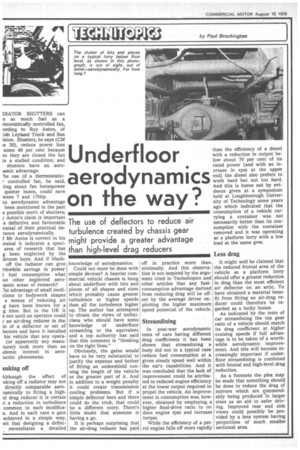Underfloor aerodynamics on the way?
Page 60

If you've noticed an error in this article please click here to report it so we can fix it.
The use of deflectors to reduce air turbulence created by chassis gear might provide a greater advantage than high-level drag reducers
DIATOR SHUTTERS can e as much fuel as a rmostatically controlled fan, ording to Roy Aston, of `.ish Leyland Truck and Bus ision. Shutters, he says (CM le 20), reduce power loss some 40 per cent because m they are closed the fan in a stalled condition; and shutters have an aeroiamic advantage.
he use of a thermostatic, controlled fan, he said, ting about fan horsepower quieter buses, could save ween 7 and 17bhp.
aerodynamic advantage been mentioned in the past a possible merit of shutters; Aston's claim is important a definitive and favourable oraisal of their practical imtance aerodynamically.
f Mr Aston is correct in his raisal it indicates a speciarea of research that has g been neglected by the :kroom boys. And if blankoff the radiator can give rthwhile savings in power fuel consumption what )ut other neglected aeroiarnic areas of research?
:le advantage of small modiitions to bodywork shapes a means of reducing air .g have been known for a g time. But in the UK it s not until an operator could 7 an air-drag reducer in the m of a deflector or set of lectors and have it installed his vehicle that any opera (or apparently any manuturer) took more than an idernic interest in aerolamic phenomena.
anldng off
klthough the effect of nking off a radiator may not directly comparable aeroiamically to fitting a highel drag reducer it is certain it a reduction in turbulence common to each modifican. And in each case a gain achieved in a simple way, reit that designing deflec. necessitates a detailed knowledge of aerodynamics.
Could not more be done with simple devices? A heavier commercial vehicle chassis is hung about underfloor with bits and pieces of all shapes and sizes which probably cause greater turbulence at higher speeds than all the turbulence higher up. The author has attempted to obtain the views of technicians who should have some knowledge of underfloor streamling or the equivalent and a top authority has said that this comment is "thinking on the right lines."
Obviously, the gains would have to be very substantial to justify the expense and bother of fitting an undershield running the length of the vehicle or the greater part of it. And in addition to a weight penalty it could create transmission cooling problems. But if a simple deflector here and there could do the trick, that could be a different story. There's little doubt that someone is having a go.
It is perhaps surprising that the air-drag reducer has paid off in practice more than minimally. And this observation is not inspired by the argument cited in Technitopics and other articles that any fuelconsumption advantage derived from reducing drag will be offset by the average driver exploiting the higher maximum speed potential of the vehicle.
Streamlining
In post-war aerodynamic tests of cars having different drag coefficients it has been shown that streamlining a body did not in a typical case reduce fuel consumption at a given steady speed well within the car's capabilities. And it was concluded that the lack of improvement could be attributed to reduced engine efficiency at the lower output required to propel the vehicle. An improvement in consumption was, however, obtained by employing a higher final-drive ratio to reduce engine rpm and increase torque.
While the efficiency of a petrol engine falls off more rapidly than the efficiency of a diesel with a reduction in output below about 70 per cent of its rated power (and with an increase in rpm at the upper end) the diesel also prefers to work hard but not too hard. And this is borne out by evidence given at a symposium held at Loughborough University of Technology some years ago which indicated that the consumption of a vehicle carrying a container was not necessarily better than its consumption with the container removed and it was operating as a platform lorry with a low load at the same gvw.
Less drag
It might well be claimed that the reduced frontal area of the vehicle as a platform lorry should offer a greater reduction in drag than the most efficient air deflector on an artic. To have obtained a material benefit from fitting an air-drag reducer could therefore be regarded as a lucky bonus.
As indicated by the tests of car streamlining the top gear ratio of a vehicle should match its drag coefficient at higher cruising speeds if full advantage is to be taken of a worthwhile aerodynamic improvement. And this will become increasingly important if underfloor streamlining is combined with frontal and high-level drag reduction.
As a footnote the plea may be made that something should be done to reduce the drag of mirrors which are commendably being produced in larger sizes as an aid to safer driving. Improved rear and side views could possibly be provided by a lens system having projections of much smaller sectional area.




































































































